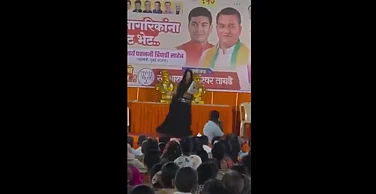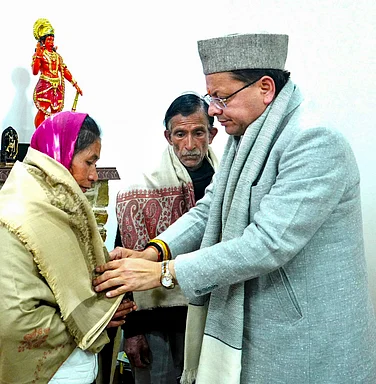THE acrid taste of excreta still lingers in Chhutni Mahato's mouth. She keeps spitting every few minutes in an apparent effort to cleanse herself. But the horrorand humiliation of having been forced to swallow faeces continues to haunt her. "They branded me a dain (witch), dragged me into a room full of strangers and stuffed my mouth with that slimy thing to exorcise the evil spirit they said was living within me...I kept screaming for help.... It was nauseating. My sari was soaked in my vomit," she recalls incoherently amid tears, clutching two of her younger children who share her dreary exile in Abuwakochha, some distance away from her native Samhram, a tribal hamlet in Bihar's Singbhum district.
Her husband, Dhananjay Mahato and the two elder children, meanwhile, battle excommunication in their cheerless home. "The village well is out-of-bounds. They are not even letting me harvest the paddy on my small patch of land. I am not allowed to sell my property and join my wife. They are waiting for me to run away so that they can grab my land," he says between dry sobs.
Ironically, Chhutni and her family are among the fortunate few. This year, in West Singbhum alone, 21 persons have been killed in what the district administration now categorises as cases of "witch-related-violence". Superstitious tribals have thought little of butchering entire families of women whom the local ojhas (witch doctors) have "identified" as witches responsible for unnatural deaths and calamities in the village.
For centuries, the simple, aboriginal people of the Chhota Nagpur plateau that spans Bihar, Orissa and parts of West Bengal, have lived under the mesmeric spell of ojhas or gunins . Animists by faith, many tribals continue to be manipulated out oftheir meagre landholdings and livestock because of their blind faith in the supernatural. Wary of outsiders, they rely totally on the ojhas for their mental and physical wellbeing. The ojhas ' influence, in turn, depends on infallibility. Whenever unable to treat an ailment, these witch-doctors invariably look for a dain to divert responsibility. The more materialistic among them conspire with the mundas (village headmen) to grab arable land—a prized possession in these barren, hilly tracts. Once a dain is identified and her family killed or excommunicated, the spoils are divided among the influential people of the village with the ojha getting his share.
This probably explains why vengeance is wreaked on the entire family rather than just the alleged witch. "They said my mother was a dain who caused the death of an elderly person. Then why did they come to kill our entire family?" asks a benumbed Krishna Boipai, who lost his father and brothers at the hands of a frenzied mob inGaitadi village of Karandih block. Paradoxically, his mother, Manikui, escaped death, but a deep gash on her forehead remains testimony to her having been branded a witch.
But Manikui is no quitter. Braving ostracism and prejudice, she continues to reside in the same village, although she has moved to its outskirts having bought another piece of land after the family property was confisc-ated. "She's always been a jhag -dalu (fightercock) woman who used to henpeck her husband," says a disapproving neighbour.
An assertive streak is, in fact, noticeable among most women branded as dains . Very often, they are women who appear to know their minds and question unjust distribution of family wealth, especially land.
Like Mejo Sundi did—-with horrific consequences. The frail, small-built woman felt her in-laws had deceived her husband by giving him the most unproductive part of the family land. And she was vocal with her protests. So, when her brother-in-law Krishna Sundi's child was taken ill, he grabbed the chance to settle scores, calling in the local ojhawho promptly pronounced her a witch.
Nine-months pregnant, Mejo escaped with her husband, running across hilly terrain under cover of darkness. But misfortune dogged her even after they found shelter in a Catholic nuns' hostel. Her "notoriety" preceded her and when a dog died nearby, the locals accused her of having been responsible. Mejo had sent her husband back home by then. Fearing that the villagers would kill her, the nuns escorted Mejo to the deputy commissioner's office in Chaibasa.
IT is here that Mejo now lives, a misfit in the semi-urban environs of the district headquarters' Yatri Niwas. Clinging tothe infant son who was born soon after she arrived here, Mejo's eyes turn moist as she remembers her husband and elder child who are still languishing in Karkagutti, their native village. "But I have forbidden him to come here. They will take away our land the moment he leaves," she mumbles through her tears. "It's not true. I'm not a dain ."
The same cry had been lost on the vio-lent, inebriated mob that had attacked and killed 18-year-old, disabled Chand Bandia's (not her real name) dain mother in Paraya village. "Ma kept screaming she was not a witch, that she hadn't killed the neighbour's son...but they hacked my father, little brothers and sisters before her eyes...then they killed ma," recalls the traumatised girl. Spared death herself, the teenager was raped by three men that fateful night. "I would have killed myself but for two of my younger siblings who survived because they were visiting relatives at another village that day," says the orphaned girl as she limps across the corridors of the PG Women's hostel in Chaibasawhere she has been provided employment as a cook by the district administration.
But prejudices persist. "She's quite strange. Keeps totally to herself. Some girls here say Chand learnt witchcraft from her mother—-so most of us keep away from her," volunteers one of the hostel's local staff in hushed tones. And her colleagues nod their consent conspiratorially.
This kind of community collusion, perhaps, emboldens the witch-hunters most. The Kuchai block police had to arrest no less than 30 villagers in Baugutto when six members of a family, including two children, were hacked to death on the allegation that two widowed women in the family practised witchcraft. "The killing had a social sanction and the villagers refused to divulge the names of the actual perpetrators of the crime," says Bhagwati Prasad Yadav, ASI of Kuchai thana. "It was quite a while before some men came forward to identify the real culprits," he recalls.
Indeed, so steeped is the tribal mindset in the supernatural that even victims are loathe to dismiss the concept of witchcraft as unreal. Mourning inconsolably for his dain wife who was pushed by irate villagers into the Subarnarekha river and her head held under water till she died, less than a month ago, Jitu Soren nevertheless confesses his faith in the existence of witches." Dains should be killed. But in Chandra-muni's case they didn't even consult an ojha ," he complains dolefully.
SOREN'S views reflect his community's conviction. They believe that spirits of the nightreside on certain trees on the outskirts of the villages, emerging as predators on moonless nights. Spirits of ancestors are formally recalled through a ritual performed after death to reinstate them in the family. As a consequence, belief in sorcery and exorcism is passed on from generation to generation. In fact, it is the youth which often takes the lead in administering violent punishment to alleged witches.
It was a group of youngsters who brutally murdered two middle-aged widows, Kuni and Jengi Balmucho, in Ulidih even as they were deep in slumber. Led by Bikram, 25, who accused the dains of "eating up" his infant daughter, the gang comprised two other boys in their early 20s and one only 15 years old. "That people my age can believe in this rubbish has me aghast," observes Nataru Sawai, Jengi's son as he stares stupe-fied at the patches of dried blood still visible on the walls of the hut where the widows lived. Sawai, who works in Bokaro, wishes he had been there to protect his mother and aunt when the killers came hunting for them.
Fortunately, protection of womentargeted for such crimes, rather than punishing criminals after the deed, is the district police's new agenda. "We have decided to play a proactive rather than reactive role. I have instructed all thanas to draw up a list of all suspected ojhas so as to hammer home our seriousness of purpose," asserts the Superintendent of Police, East Singhbhum, Dr Ajay Kumar, who is already a legend in the region for havingsuccessfully rid Jamshedpur of its mafia.
Deputy Commissioner West Singbhum, Amit Khare, is equally upbeat: "I'm certain the next generation will combat these prejudices," he asserts, pointing out that all 1,300 government schools in his district are being sensitised to the issue through posters in Hindi as well as the local Ho dialect. Moreover, Khare has despatched blank postcards to all Inte-grated Child Development Scheme cen-tres under his charge so that they can inform him whenever they think a witch-hunt is being plotted.
To further galvanise public opinion against this hangover of medieval barbarism, Khare also organises public rallies under the aegis of the Andh Vishwas Nivaran Abhiyan. Well-attended meetings have been held in villages like Kharswan, Majhgaon, Patagoera and Khurdpani in Singbhum district. "Even political parties are coming forward to support our movement," the deputy commissioner points out. "Earlier, they thought their vote banks would revolt. But now, opposition to witch-hunts is regarded as politically correct," he exclaims with some satisfaction.
While the administration looks forward to a forthcoming legislation which will empower them to act with alacrity ( see box ), Fagu Soren, who heads the Tribal and Harijan Welfare Cell of Tata Steel, says education is the only remedy to cure people of such irrationality. "The Tatas, being the dominant force in the local economy, plan to upgrade their social awareness budget next year to combat this superstition," Soren avers enthusiastically.
It may take decades to exorcise Chhota Nagpur's scourge. But then, many already seem possessed by the spirit to combat the evils of superstition.






















.png?w=200&auto=format%2Ccompress&fit=max)



